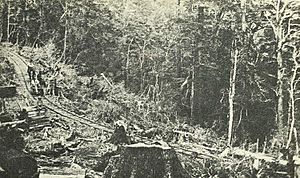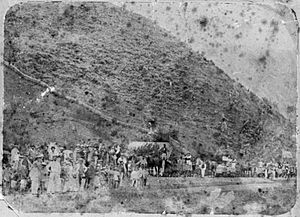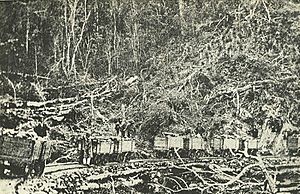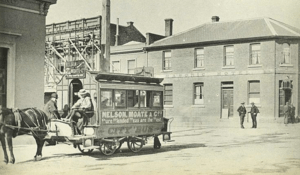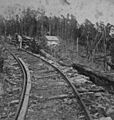Dun Mountain Railway facts for kids
Quick facts for kids Dun Mountain Railway |
|
|---|---|
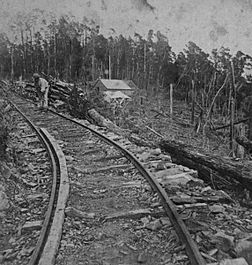
Dun Mountain Railway
|
|
| Overview | |
| Status | Closed |
| Owner | Dun Mountain Company Robert Levien Moses Crewdson Jonathan Harle Nelson City Council |
| Locale | Nelson, New Zealand |
| Termini | Hardy Street, Nelson (passenger), Wooded Peak (freight) Nelson Port |
| Stations | 2 (passenger) 4 (freight) |
| Service | |
| Type | Tramway |
| Operator(s) | Dun Mountain Company Thomas Nesbitt James McConkey William Weeden and Alfred Brind Bray Bros. William Taylor Stevenson and McGlashan Thomas Newton Robert Levien Moses Crewdson Jonathan Harle Nelson City Council |
| History | |
| Opened | 3 February 1862 |
| Closed | January 1866 (freight) 30 May 1901 (passenger) |
| Technical | |
| Line length | 21.5 km (13.4 mi) (original) 1.8 km (1.1 mi) (subsequent to the closure and lifting of the incline) |
| Character | mountainous, suburban |
| Track gauge | 3 ft (914 mm) |
The Dun Mountain Railway was the very first railway to open in New Zealand. It was a special kind of railway called a tramway, built to carry minerals. This railway was owned by a private company.
It was about 21.5 km (13.4 mi) long and used horses to pull wagons. The railway connected chromite mines near Wooded Peak to the port in Nelson. It operated from February 3, 1862, until May 30, 1901.
This railway opened before any other public railway in New Zealand. It even started before the first steam train railway, which opened in December 1863. Nelson also had New Zealand's first city tramway to open and close.
Contents
The Story of the Dun Mountain Railway
How the Idea Started
In 1853, a local farmer named George Duppa found a lot of a mineral called chromite. This was near Wooded Peak, about 8 kilometers from Nelson. At first, people didn't think it was worth much money.
However, some people, like William Wrey, believed these minerals could be very valuable. They realized they would need a railway to move the minerals from the mountains to Nelson. They tried to get money for the project in New Zealand, but it didn't work.
So, Wrey went to England to find investors. He was successful! Twenty rich people in London each gave £500. This led to the creation of the New Zealand Land Fund Association.
Later, in 1857, a new company was formed called the Dun Mountain Copper Mining Company Ltd.. They planned to build a railway about 16-kilometre (9.9 mi) long. Horses would pull wagons up the hill, and gravity would pull them down.
Finding the Right Minerals
An engineer named Thomas Hacket came to Nelson to check the copper. He found that there wasn't enough copper to make mining profitable. But he was very impressed by the chromite that had been found earlier.
After testing, the chromite was found to be of high quality. This convinced the company to start mining chromite instead of copper. They decided to build a tramway from the Coppermine Saddle to Nelson Port.
Building the Railway
Two engineers from Ireland, William Doyne and Abraham Fitzgibbon, were hired to build the railway. They arrived in Nelson in July 1860.
They decided on a new, better route for the railway through the Brook Valley. This change meant they had to get new permission from the government.
Workers started building the railway in sections. One part was 5.8-kilometre (3.6 mi) long and included making a wide ledge on the side of Wooded Peak. They also built drainage and six bridges.
Another section was 11-kilometre (6.8 mi) long. This part had a steep slope, making it a challenge to build.
The company needed about 24,000 wooden sleepers for the tracks. They bought them from sawmills.
Finally, in August 1861, the law allowing the railway to be built on public land was passed. This meant construction could begin on the parts of the railway that went through Nelson's streets. This section was finished in just four months.
The last rails arrived in October 1861, and the very last rail was laid in January 1862.
The Grand Opening
The Dun Mountain Railway officially opened on February 3, 1862. About £75,000 had been spent on the whole project. A big part of that money went into building the railway itself.
At noon on opening day, horse-drawn wagons left the company's depot. The Nelson Brass Band rode in the first wagons, playing music. Company officials and guests rode in the next wagons. The rest of the wagons were filled with chromite ore.
The procession went through streets filled with people and decorated with flags. When they reached the port, the ore was unloaded. Then, everyone returned to town.
To thank the workers, the company gave them a paid holiday and a special lunch. Speeches were given, and everyone celebrated the new railway.
How the Railway Worked
Carrying Freight (Minerals and Goods)
The railway was not allowed to use steam engines in the city. This was fine because the company planned to use horses to pull empty wagons up the hill. Then, gravity would pull the full ore wagons down.
Horses pulled empty wagons up to the mines at about 4 miles per hour (6.4 km/h). Once the wagons were full, they would roll down to Nelson. A brakeman controlled their speed.
It was important for the wagons to go slowly, around 4 miles per hour (6.4 km/h). The railway had over 700 curves, so going too fast could cause a derailment (when the train goes off the tracks).
In February 1862, the company said that only ore could be carried in the wagons. They needed all 20 wagons for the minerals. By March 1862, they added 25 more wagons to carry even more ore.
By late 1862, the company realized there wasn't as much chromite as they first thought. Mining stopped in early 1863 because it wasn't making enough money. After that, the company earned money by selling firewood, timber, and gravel. They also made money from the passenger tram service.
However, the chromite market improved in mid-1863. The company started mining again later that year. They even bought a share in a dye manufacturing company in Wales to ensure a steady demand for their ore.
The company also found new ways to earn money. They sold lime from a kiln and leased wagons to local businesses to carry goods from the port.
Carrying Passengers (The City Bus)
Even though the railway was mainly for minerals, the company also planned for passenger services. The law said they had to run at least one daily passenger service between the city and the port.
For passengers, the company ordered a horse-drawn tram from Australia in late 1861. This tram became known as the "Dun Mountain Bus" or "City Bus." It arrived in Nelson in March 1862.
The first person to operate the tram was Thomas Nesbitt. The first passenger service ran on Saturday, May 3, 1862. People were worried the tram might be wobbly because of its narrow tracks, but it was fine. Regular services started the following Monday.
The tram left every half-hour from either the Port or Hardy Street. It provided a reliable daily service. Even though the speed limit was 4 mph (6.4 km/h), the tram often went faster, around 6 to 7 mph (9.7 to 11.3 km/h).
Later, James McConkey took over the tram lease. He made changes to make the ride more comfortable. He also lowered the daytime fare to 3d (an old form of currency).
By 1864, the tram services increased to every half-hour in both directions. This showed how popular the tram was! New rules were also introduced, like no smoking on the tram and penalties for not buying a ticket.
Over the years, different people and companies operated the tram service. In 1872, the passenger part of the railway was sold to Moses Crewdson. He improved the service, even painting the tram. He renamed it Crewdson's City Bus. He even bought a second tram!
In 1884, Jonathan Harle became the last owner of the tram service. He continued the postal delivery contract and even sold special tickets that included a tram ride and entry to the Marine Baths.
The End of the Railway
End of Freight Services
The good times for the mining company didn't last long. By late 1864, after exporting 768 tonnes of ore, they found that most of the good chromite was gone. Mining stopped again. The company still used the railway to carry firewood, rock, and lime.
In 1866, the company decided to close down. They tried to sell the railway and other assets several times but couldn't find a buyer.
Even though chromite mining wouldn't restart, the company hoped to find other valuable minerals. But surveys in 1870 and 1871 confirmed there were no other useful mineral deposits.
So, in 1871, the company decided to sell everything. In May 1872, all the company's assets were sold to a local merchant named Robert Levien for £4,750. This was a very low price compared to what had been invested.
Levien quickly sold off parts of the railway. The section from Trafalgar Street to the mines was removed and sold by the end of 1872.
End of Passenger Services
By 1893, the tram had been running for over 30 years. It was getting old, and maintenance costs were too high. Jonathan Harle, the owner, tried to sell the service, but no one wanted to buy it. He then offered it to the Nelson City Council, but they also said no because of the high repair costs.
In January 1901, business owners and cab drivers complained to the council about the railway's poor condition. The council decided to buy and dismantle the railway.
On May 30, 1901, the city bought the railway and trams. The very last passenger journey happened that same day. Important local people, including the Mayor, rode on this final trip.
The council voted to remove the rails on June 7, 1901. The work started on June 26 and was finished by July 6. The wooden sleepers were sold, but many of the rails were kept by the council for other uses. The trams themselves were sold at an auction later that year.
Railway Stations
The Dun Mountain Railway didn't have fancy stations on the uphill section. Instead, it had four depots called "houses."
- The First House was at the start of the uphill section. It had storage, workshops for carpenters and blacksmiths, stables for horses, and houses for staff.
- Third House was about halfway up, at the Wairoa Saddle.
- Second and Fourth Houses were smaller buildings for maintenance and shelter.
For the passenger service, the company planned for stations in Nelson. They suggested four stops:
- Alton Street
- Outside the Masonic Hotel
- Near the City Market Hall
- At the Government Wharf at the port
Later, they decided only two main stops were needed: one at the port and a temporary one outside the Masonic Hotel. The council agreed, as long as the footpath wasn't blocked and no buildings were put on the road.
What Remains Today
Today, you won't find any signs of the City Bus in Nelson itself. However, you can still walk along the old uphill section of the Dun Mountain Railway from Brook Street. Some parts of the old City Bus route look very different now because of changes made to the Nelson Haven area.
Images for kids


